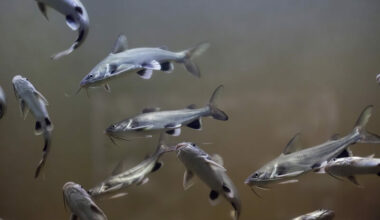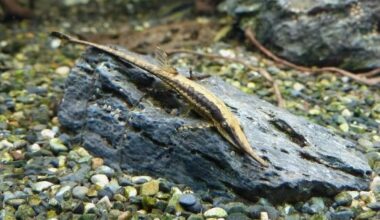Pablo Picasso is known as the co-founder of the Cubist movement which takes apart objects and analyzes them in terms of their shapes, and the Picasso Triggerfish is known for taking apart its food and making all kinds of shapes of the crushed shells using its big teeth and strong jaws.
In this guide you won’t learn about art (aside from the cool image below) but you will learn the best ways to care for your Picassofish.

Table of Contents
Species Summary
Picasso Triggerfish, known by their Hawaiian name as Humu-Humu, are an aggressive species of saltwater fish who stick to shallow reefs and lagoons. They are found across the Indo-Pacific from the Philipines to Hawaii.
Picassos violently defend their territory and spend their days searching the lagoon or reef bed for the crustaceans and squid they usually prey on. They are lone fish that form harems during the breeding season composed of a single male and multiple females.
These Triggers are Hawaii’s state fish and a widespread part of the island diet. Their full Hawaiian name is humu humu nuka nuka apua’a, which roughly translates to “the fish that snorts like a pig.”
Author Note: Picassos make a deep grunting noise. This adaptation is an intimidation technique used to ward off predators. The loud noise can even startle fishermen when they grip the fish, increasing their odds of being dropped back into the sea.
Known scientifically as Rhinecanthus aculeatus, Picassos are closely related to the more common Reef Triggerfish, or Rhinecanthus rectangulus, which inhabit the same Hawaiian and Indo-Pacific waters.
Picassos are beautiful and hardy fish, making them excellent for aquarists of any skill level. The primary challenge is handling their aggressive behavior and disruptive nature to maintain communal harmony and tank integrity.
Appearance
Aptly named for the famous abstract painter Pablo Picasso, these Triggers have bold colors and sharp contrasts. They have an oval shape and the flat appearance of many other tropical fish species. Picassofish have a fan-like dorsal fin that runs near the back of their body and a slightly elongated tailfin.
Like all Triggers, Humu-Humu have the characteristic retractable spikes they use to secure themselves in rock. The fish has relatively small pectoral fins for its long, broad body.

These fish have leathery skin with uniformly arranged diamond scales. Picassos have tannish-grey bodies with darker shading near the tailfin. Their bellies are white. They have blue and black stripes crossing the crown of their head, which cover their prominent orange eyes.
A yellow line encircles the mouth. A second yellow stripe runs from the corners of their mouth to just below the dorsal fins, creating a smile-like effect.
Lifespan
Humu-Humu can have a lifespan of up to 10 years in captivity, so long as you maintain their tank conditions and monitor for aggressive behavior from other fish.
Average Size
Adult Picassos reach 10 to 12 inches in size. Males are slightly larger than females. These fish cannot be accurately sexed based on size because the difference is negligible.
Picasso Triggerfish Care
As with any fish, the proper care to maximize the longevity of your Picasso Triggerfish is done by effectively simulating the natural environment. Optimizing their conditions minimizes stress and also increases their likelihood to remain active and engage with your tank so you can enjoy their fascinating behaviors.
Author Note: Fortunately, Picassos are hardy and resilient fish that only require space and stable water conditions to thrive. While the primary challenge is managing their aggressive and active nature, their waste produces tremendous amounts of ammonia.
Their messy eating habits add to pollutant buildup because they leave a lot of organic material to decay in your tank. Despite these challenges, with active monitoring, these fish are an excellent tank addition.
Tank Size
Picasso Triggerfish are highly-territorial and violently defend their claim, and for this reason a tank size of 120-gallon or more is essential. The bigger, the better because Picassos are curious swimmers and will scour the tank. While most experts advise against keeping more than one Humu-Humu, you will need an even larger tank if you attempt to keep a pair of these Triggers.
Water Parameters
- Water temperature: 76 to 82°F
- pH levels: 8.1 to 8.4
- Water hardness: 8 to 12 dKH
- Specific gravity: 1.021 to 1.025 sg
What To Put In Their Tank
Picassos need spacious tanks containing enough live rock to form hiding spots and areas for exploration. Your fish will be like a wrecking crew, continually digging into the substrate, overturning rock, and gnawing on inorganic material it finds. The larger rocks must be secured and stable to prevent collapses or cave-ins that could injure or crush the tank inhabitants.
Be sure filters, tubing, and any exposed wiring is secured and out of the Picasso’s reach. They are active chewers who will toy with anything. These fish are not reef-safe because they tend to dig and uproot material, dislodging and crushing coral. They will also consume any invertebrates you attempt to use to accent your tank.
Common Possible Diseases
Humu-Humu are resilient fish but are susceptible to Marine Ich and other diseases that commonly affect tropical saltwater fish. Fortunately, they typically respond well to treatment. It is always best to quarantine ailing fish in a separate tank while you nurse them back to health.
Food & Diet
Finding the proper diet for your Picasso Triggerfish will be one of the least challenging facets of keeping them. They are voracious eaters who will consume almost any meaty protein you provide. In the wild, they hunt by blowing bubbles in the substrate to unearth crustaceans and sea urchins. Their ever-growing sharp teeth are perfect for extremely territorial..
In the tank, you can provide live or frozen food. Smaller snails, crabs, clams, mussels, whole shrimp, and other invertebrates are excellent choices. They will also consume pieces of raw fish. Varying your Piccaso Triggerfish’s diet will maximize their nutrition and keep them engaged with feedings.
Be sure to consistently provide foods with hard outer shells to wear down the Picasso’s teeth. Without a proper diet, the teeth will grow uncontrollably, causing the fish discomfort and creating a pathway for disease or infection. Experts suggest two to three feedings per day.
Author Note: Monitor your fish for intake and do your best to skim leftover organic matter from the tank. These food remnants break down, releasing harmful chemicals that alter your tank conditions.
You can attempt to begin juvenile Picassos on pellets, but wild-caught adults are unlikely to accept them. If you want to try pellet feedings, check labels and only buy formulations with high protein content and low carbohydrates. These large active fish need protein to maintain their health and strength.
Behavior & Temperament
These Triggers are active swimmers, territorial, and curious. Your Picasso will be most active during the day, combing the tank floor and investigating the rocks. They are relentless and do well with the stronger currents needed for adequate water filtration. Picassos will cover every level of your tank because they naturally spend their time in shallow lagoons.
The Picassofish will become anxious without adequate hiding space and spots to sleep at night. They are aggressive toward other fish and deliver vicious bites when provoked or threatened. Monitor the dynamics in your tank and exercise additional caution when introducing new fish to the aquarium.

Author Note: Divers have reported that Picassos are unafraid and will bite in the wild, especially during mating season. Unsurprisingly, reaching into your tank to perform cleaning or maintenance can be risky. Picassos explore with their mouths. They may bite your arm over a perceived threat or simple fascination with new stimuli.
Picassos are so active due to their territoriality. Their impulse is to patrol their area, monitoring for intruders. Their tendency to burrow comes from their natural adaptation to root out hiding spaces. They will butt their head against the rock and aggressively swim to move large structures or blow bubbles into the substrate to create depressions.
Picasso Triggerfish Tank Mates
Experts suggest that Triggerfish can safely reside with any comparably-sized aggressive fish. Housing fish of similar temperaments ensures everyone can stand up for themselves. Your Picasso will eat crabs, shrimp, snails, and other crustaceans. Passive fish and those small enough to fit in the Trigger’s mouth should not be tank mates.
If you hope to keep more than one Picasso, it is best to introduce two juveniles to the tank as a pair. The resulting familiarity may promote coexistence as the fish age. Considering their strong territorial instincts and solitary nature, keeping multiple Humu-Humu is risky.
Suitable tank mates include:
- Domino Damselfish
- Dog-faced Pufferfish
- Foxface Rabbitfish
- Hippo Tangs
- large Marine Angelfish (like the Emperor Angelfish)
- Lionfish
- Marine Bettas
- Powder Blue Tangs
- Ribbon Eels
- similar sized Surgeonfish
- Snowflake Eels
- Wrasses
Breeding
Picassos are difficult to breed in commercial settings and impossible to mate in a home tank. In the wild, the territory of a single male overlaps with that of four to five females. During the breeding season, the female digs a nest-like structure in the sand.
Once fertilized, she lays eggs and aggressively guards the nest while she waits for the offspring to hatch. She departs after the young emerge from their eggs, leaving the juveniles to fend for themselves. Picassos mate at dawn and the spawn swim off by sunset the same day. Beyond the difficulty of housing two Picassos together, home aquarists cannot recreate the nesting conditions.
Conclusion
Although you did not learn much about art in this guide, we hope you learned a lot about properly caring for your Picasso Triggerfish and remember to always keep a distance between your fingers and their teeth.
This fish could be a great addition to your saltwater aquarium specially if you already have some of its suitable tank mates. Good luck with your Humu-Humu and don’t forget to visit us often to check for new and amazing fish content!
And don’t forget to check our other care guides and to tag us on facebook with a nice photo of your fish 😉

